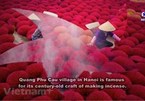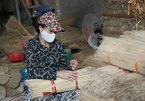Located along National Highway 3, from Cao Bang city to Trung Khanh, Phia Thap village in Quoc Dan commune, Quang Uyen district with more than 50 households of the Nung An ethnic people has preserved the traditional profession of making incense for hundreds of years.
In Vietnamese culture, incense sticks are considered a bridge between the present life and the spiritual world. The incense making profession of the Nung An people in Phia Thap village has been passed down from generation to generation. All villagers know how to make incense.
Phia Thap incense is made entirely from natural materials: wood of mai tree, bark of gao tree, sawdust and especially the leaves of bau hat tree in the forest.
Making incense not only brings income to the people of Phia Thap village but also contributes to preserving a traditional profession of the Nung An people.
|
The peaceful Phia Thap village with typical stilt houses of the Nung people. |
|
Bouquets of incense spreading out like flower petals are dried on the road in Phia Thap village. |
|
Mai trees are cut into pieces about 40cm long, then split into small bars like chopsticks, then sharpened. |
|
Quite a few stages require the incense maker to be very skillful and meticulous. |
|
Leaves of bau hat tree and bark of gao tree are milled and mixed with sawdust. Sticks made from mai trees are dipped in water mixed with powder made from the leaves of bau hat trees to create binder. |
|
The sticks are soaked in the mixture of powder of bau hat leaves, bark of gao tree, and sawdust to become incense sticks. |
|
Finally, these sticks are rolled on the coloring agent then dried under the sun. |
|
If it is sunny, it will take incense sticks a day to dry or 3-4 days on cloudy days. |
|
Incense sticks are dried everywhere. |
|
When they are dry, incense sticks are dipped in food coloring to have a beautiful red color. This coloring is also made from natural wood pulp. |
|
Finally, incense sticks are tied into bundles, with 20 sticks each. Each small bundle is priced for 10,000-20,000 VND. |
Pham Quang Vinh

Quang Phu Cau incense-making village
Before the bulletin comes to an end, let’s join us in a visit to Quang Phu Cau village, an incense making village in Ung Hoa district in Hanoi.

Incense village struggles to reignite post-pandemic
Traditional handicraft villages have started to resume operation after more than two months of suspension due to the fourth coronavirus outbreak in late April that forced the capital city to follow strict social distancing measures.